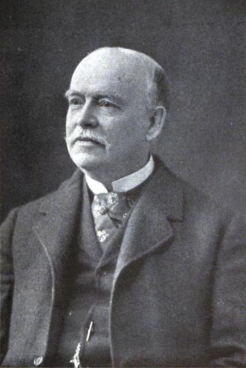
Josiah Cleaveland Cady was an American architect known for his Romanesque Revival designs. He was also a founder of the American Institute of Architects.
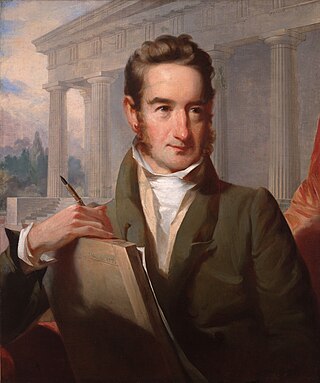
William Strickland was a noted architect and civil engineer in Philadelphia, Pennsylvania, and Nashville, Tennessee. A student of Benjamin Latrobe and mentor to Thomas Ustick Walter, Strickland helped establish the Greek Revival movement in the United States. A pioneering engineer, he wrote a seminal book on railroad construction, helped build several early American railroads, and designed the first ocean breakwater in the Western Hemisphere. He was elected as a member of the American Philosophical Society in 1820.

The First Presbyterian Church in Chattanooga, Tennessee, located at 554 McCallie Avenue, is a historic, downtown congregation of the Presbyterian Church in America (PCA). It was the first Christian congregation founded in the city.

The Downtown Presbyterian Church in Nashville, Tennessee, a part of the Presbyterian Church (USA), was formerly known as First Presbyterian Church. The church is located at the corner of Rep. John Lewis Way and Church Street. As Old First Presbyterian Church it was designated a National Historic Landmark in 1993, for its distinctive Egyptian Revival architecture.

Gallatin First Presbyterian Church is a historic church in Gallatin, Sumner County, Tennessee, affiliated with Presbyterian Church (USA).

The First Congregational Church is a historic church building in the Marcy-Holmes neighborhood of Minneapolis, Minnesota, United States, built in 1886. It is constructed of red sandstone in Gothic-Romanesque style, featuring round-arched windows and semi-circular rows of pews. When initially completed, the building was in a residential neighborhood surrounded by mansions of prominent citizens and merchants of the time, including Octavius Broughton, Woodbury Fisk, Thomas Andrews, Horatio P. Van Cleve, William McNair, and John Dudley. Over time the neighborhood changed to a more transient population, dominated by students attending the University of Minnesota. Architect Warren H. Hayes (1847-1899) was Minneapolis' leading designer of churches in the 19th century, having designed the Calvary Baptist Church, Fowler Methodist Episcopal Church, and Wesley Methodist Episcopal Church, as well as the Central Presbyterian Church in Saint Paul.
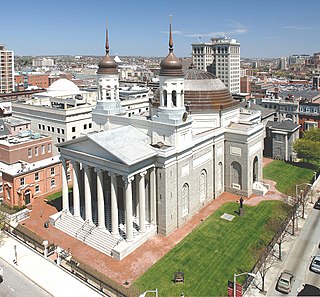
The Cathedral Hill Historic District is an area in Baltimore, Maryland. It lies in the northern part of Downtown just south of Mount Vernon. Roughly bounded by Saratoga Street, Park Avenue, Hamilton Street, and St. Paul Street, these 10 or so blocks contain some of the most significant buildings in Baltimore. The area takes its name from the Basilica of the Assumption which sits in the heart of the district. Despite the number of large religious structures in the area, the district's buildings are primarily commercial in character, with a broad collection of significant commercial structures ranging in date from 1790 to 1940.
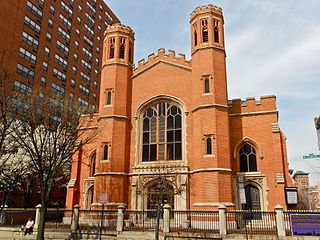
Franklin Street Presbyterian Church and Parsonage is a historic Presbyterian church located at 100 West Franklin Street at Cathedral Street, northwest corner in Baltimore, Maryland, United States. The church is a rectangular Tudor Gothic building dedicated in 1847, with an addition in 1865. The front features two 60 foot flanking octagonal towers are also crenelated and have louvered belfry openings and stained glass Gothic-arched windows. The manse / parsonage at the north end has similar matching walls of brick, heavy Tudor-Gothic window hoods, and battlements atop the roof and was built in 1857.

First Presbyterian Church is a historic church located at 120 East State Street in Trenton, Mercer County, New Jersey, United States. The church's first congregation got together in 1712 and their first church was built in 1726. The church building and churchyard cemetery were added to the National Register of Historic Places for their significance in architecture, politics, religion, and social history on September 9, 2005.

The Fairmount Historic District is a 409-acre (166 ha) historic district located along County Route 517 in the Fairmount section of Tewksbury Township, near Califon, in Hunterdon County, New Jersey. It was added to the National Register of Historic Places on December 20, 1996 for its significance in architecture, exploration/settlement, and industry. The district includes 72 contributing buildings that were deemed to be contributing to the historic character of the area, plus five contributing structures, nine contributing sites, and one contributing object. One contributing building is located in Washington Township, Morris County.

Shofner's Lutheran Chapel is a historic church on Thompson's Creek near Shelbyville, Tennessee, United States. The church and adjacent cemetery are listed on the National Register of Historic Places as Shofners' Lutheran Church and Cemetery.

St. Marks Presbyterian Church is a historic African-American Presbyterian church in Rogersville, Tennessee. Its building was added to the list of National Register of Historic Places in March 10, 2006.

Beth Salem Presbyterian Church is a historic African-American church in Athens, Tennessee.

The McCook Family Estate is a historic mansion located at 5105 Fifth Avenue in the Shadyside neighborhood of Pittsburgh, Pennsylvania, USA. It was built during 1906 and 1907 for Willis McCook and his family. McCook was a prominent businessman and lawyer who represented Henry Clay Frick.

Tindley Temple United Methodist Church, also known as Tindley Temple Methodist Episcopal Church and Calvary United Methodist Church, is a historic Methodist Episcopal church located in the Southwest Center City neighborhood of Philadelphia, Pennsylvania. It was built between 1923 and 1928, and is a large masonry building influenced by the Beaux-Arts Romanesque and Art Deco styles.

The Montrose Historic District is a national historic district located in Montrose, Susquehanna County, Pennsylvania. The district encompasses 386 contributing buildings and two contributing sites in the central business district and surrounding residential areas of Montrose.

The Third Presbyterian Church was a historic Presbyterian Church founded in 1872 in Chester, Pennsylvania. It was located at 9th and Potter Streets. The church was the location of the first summer bible school in 1912. The congregation closed in 1986 and was thereafter owned by the Chester Historical Preservation Committee. It was a stone Gothic Revival building designed by the noted Philadelphia architect Isaac Pursell. The church was listed on the National Register of Historic Places in November 2019 but severely damaged by a five-alarm fire on May 28, 2020.

The Old Stone Church is a historic sandstone church located in Kingwood Township in Hunterdon County, New Jersey, United States. It was built in 1837 and is now owned by the First Unitarian Universalist Fellowship of Hunterdon County. The church, described using its historic name, Old Stone Presbyterian Church in Kingwood, was added to the National Register of Historic Places on January 25, 2018 for its significance in architecture. The earlier church located here was a smaller stone building built in 1755, called the Old Stone Meetinghouse. The stones from this church were probably used to build the current one. The Kingwood congregation was established in 1728 and grew during the First Great Awakening, with Gilbert Tennent and George Whitefield preaching here in 1739.

The Asbury Historic District is a 288-acre (117 ha) historic district encompassing the community of Asbury in Franklin Township of Warren County, New Jersey. It is bounded by County Route 632, County Route 643, Maple Avenue, Kitchen Road, and School Street and extends along the Musconetcong River into Bethlehem Township of Hunterdon County. It was listed on the National Register of Historic Places on March 19, 1993 for its significance in architecture, industry, religion, community development, politics/government, and commerce. The district includes 141 contributing buildings, a contributing structure, two contributing sites, and four contributing objects.
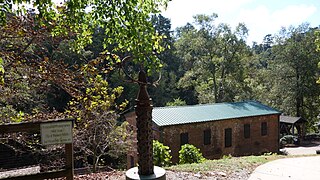
The Roswell Historic District, in Roswell, Georgia in Fulton County, was listed on the National Register of Historic Places in 1974.























